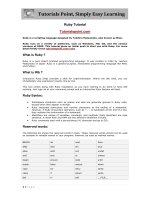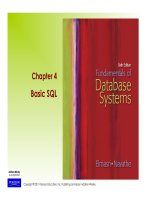Oxygen XML editor english ebook
Bạn đang xem bản rút gọn của tài liệu. Xem và tải ngay bản đầy đủ của tài liệu tại đây (11.84 MB, 1,028 trang )
Oxygen XML Editor 16.1
Notice
Copyright
Oxygen XML Editor User Manual
Syncro Soft SRL.
Copyright
©
2002-2014 Syncro Soft SRL. All Rights Reserved.
All rights reserved. No parts of this work may be reproduced in any form or
by any means - graphic, electronic, or mechanical, including photocopying,
recording, taping, or information storage and retrieval systems - without the
written permission of the publisher. Products that are referred to in this document
may be either trademarks and/or registered trademarks of the respective owners.
The publisher and the author make no claim to these trademarks.
Trademarks. Many of the designations used by manufacturers and sellers to
distinguish their products are claimed as trademarks. Where those designations
appear in this document, and Syncro Soft SRL was aware of a trademark claim,
the designations have been rendered in caps or initial caps.
Notice. While every precaution has been taken in the preparation of this
document, the publisher and the author assume no responsibility for errors or
omissions, or for damages resulting from the use of information contained in
this document or from the use of programs and source code that may accompany
it. In no event shall the publisher and the author be liable for any loss of profit
or any other commercial damage caused or alleged to have been caused directly
or indirectly by this document.
Link disclaimer. Syncro Soft SRL is not responsible for the contents or
reliability of any linked Web sites referenced elsewhere within this
documentation, and Syncro Soft SRL does not necessarily endorse the products,
services, or information described or offered within them. We cannot guarantee
that these links will work all the time and we have no control over the availability
of the linked pages.
Warranty. Syncro Soft SRL provides a limited warranty on this product. Refer
to your sales agreement to establish the terms of the limited warranty. In addition,
Oxygen XML Editor End User License Agreement, as well as information
regarding support for this product, while under warranty, is available through
the Oxygen XML Editor website.
Third-party components. Certain software programs or portions thereof
included in the Product may contain software distributed under third party
agreements ("Third Party Components"), which may contain terms that expand
or limit rights to use certain portions of the Product ("Third Party Terms").
Information identifying Third Party Components and the Third Party Terms that
apply to them is available on the Oxygen XML Editor website.
Downloading documents. For the most current versions of documentation, see
the Oxygen XML Editor website.
Contact Syncro Soft SRL. Syncro Soft SRL provides telephone numbers and
e-mail addresses for you to report problems or to ask questions about your
product, see the Oxygen XML Editor website.
Contents
Chapter 1: Introduction 21
Chapter 2: Installation 25
Installation Options 26
Windows Installation 26
Mac OS X Installation 28
Linux Installation 30
Windows NT Terminal Server Installation 31
Linux Server Installation 33
Java Web Start (JWS) Installation 34
Site-wide deployment 36
Licensing 36
Setting up a License Server 40
Transferring or Releasing a License 43
Upgrading 44
Installing and Updating Add-ons 45
Uninstalling 46
Installer Command Line Reference 46
Chapter 3: Getting Started 49
Your First XML Document 50
Your First DITA Topic 54
Chapter 4: Perspectives 61
Perspectives 62
Editor Perspective 62
XSLT Debugger Perspective 65
XQuery Debugger Perspective 65
Database Perspective 66
Dockable Views and Editors 67
Chapter 5: Editing Modes 71
Text Editing Mode 72
The Undo/Redo Actions 72
Copying and Pasting Text 72
Finding and Replacing Text in the Current File 72
Oxygen XML Editor | Contents | 5
Finding and Replacing Text in Multiple Files 76
Changing the Font Size 79
Word/Line Editor Actions 79
Dragging and Dropping the Selected Text 79
Inserting a File at Caret Position 79
Opening the File at Caret in System Application 79
Opening the File at Caret Position 79
Printing a File 80
Bidirectional Text Support in Text Mode 81
Grid Editing Mode 81
Layouts: Grid and Tree 82
Grid Move Navigation 82
Specific Grid Actions 83
Drag and Drop in the Grid Editor 84
Copy and Paste in the Grid Editor 85
Bidirectional Text Support in Grid Mode 86
Author Editing Mode 87
Tagless XML Authoring 87
General Author Presentation 88
Smart Paste Support 135
Bidirectional Text Support in Author Mode 135
Chapter 6: Editing Documents 139
Working with Unicode 140
Opening and Saving Unicode Documents 140
Inserting Symbols 141
Creating, Opening, and Closing Documents 141
Creating Documents 141
Saving Documents 145
Opening/Navigating Documents 146
Opening and Saving Remote Documents via FTP/SFTP/WebDAV/SharePoint 153
Opening the Current Document in System Application 158
Switching Between Opened Tabs 158
Closing Documents 158
The Contextual Menu of the Editor Tab 159
Viewing File Properties 159
Grouping Documents in XML Projects 159
Using the Project View 160
Defining Master Files at Project Level 165
Editing XML Documents 169
Associate a Schema to a Document 169
Streamline with Content Completion 172
Validating XML Documents 178
Document Navigation 189
Oxygen XML Editor | Contents | 6
Large Documents 193
Working with XML Catalogs 195
XML Resource Hierarchy/Dependencies View 197
Converting Between Schema Languages 199
Editing XML Tree Nodes 201
Formatting and Indenting XML Documents 201
Editing Modular XML Files in the Master Files Context 205
Managing ID/IDREFS 205
Search and Refactor Operations Scope 207
Viewing Status Information 208
Image Preview 209
Making a Persistent Copy of Results 209
Locking and Unlocking XML Markup 209
Adjusting the Transparency of XML Markup 210
XML Editor Specific Actions 210
XML Quick Fixes 215
Editing XHTML Documents 216
Editing XSLT Stylesheets 216
Validating XSLT Stylesheets 216
Editing XSLT Stylesheets in the Master Files Context 217
Syntax Highlight 217
Content Completion in XSLT Stylesheets 217
The XSLT/XQuery Input View 222
The XSLT Outline View 224
XSLT Stylesheet Documentation Support 226
Generating Documentation for an XSLT Stylesheet 227
Finding XSLT References and Declarations 233
Highlight Component Occurrences 234
XSLT Refactoring Actions 234
XSLT Resource Hierarchy/Dependencies View 235
Component Dependencies View 238
XSLT Quick Assist Support 239
XSLT Quick Fix Support 240
Linking Between Development and Authoring 242
XSLT Unit Test (XSpec) 242
Editing Ant Build Files 243
Validate Ant Build Files 243
Editing Ant Build Files in the Master Files Context 244
Syntax Highlight 244
Content Completion in Ant Build Files 244
Ant Outline View 244
Find References and Declarations of Ant Components 246
Highlight Component Occurrences 247
Ant Refactoring Actions 247
Ant Resource Hierarchy/Dependencies View 247
Oxygen XML Editor | Contents | 7
Ant Component Dependencies View 248
Ant Quick Assist Support 249
Ant Quick Fix Support 249
Editing XML Schemas 249
XML Schema Diagram Editing Mode 250
XML Schema Text Editing Mode 283
Editing XML Schema in the Master Files Context 285
Searching and Refactoring Actions 285
Component Dependencies View 287
XML Schema Quick Assist Support 288
XML Schema Resource Hierarchy / Dependencies View 289
Generating Documentation for an XML Schema 292
Flatten an XML Schema 299
Generate Sample XML Files 301
XML Schema Regular Expressions Builder 305
Create an XML Schema From a Relational Database Table 307
XML Schema 1.1 307
Setting the XML Schema Version 308
Linking Between Development and Authoring 309
Editing XQuery Documents 309
XQuery Outline View 309
Folding in XQuery Documents 310
Generating HTML Documentation for an XQuery Document 311
Editing WSDL Documents 312
WSDL Outline View 312
Content Completion in WSDL Documents 315
Editing WSDL Documents in the Master Files Context 316
Searching and Refactoring Operations in WSDL Documents 317
Searching and Refactoring Operations Scope in WSDL Documents 317
WSDL Resource Hierarchy/Dependencies View in WSDL Documents 318
Component Dependencies View in WSDL Documents 321
Highlight Component Occurrences in WSDL Documents 322
Quick Assist Support in WSDL Documents 322
Generating Documentation for WSDL Documents 323
WSDL SOAP Analyzer 326
Editing CSS Stylesheets 329
Validating CSS Stylesheets 329
Content Completion in CSS Stylesheets 330
CSS Outline View 330
Folding in CSS Stylesheets 331
Formatting and Indenting CSS Stylesheets (Pretty Print) 331
Minifying CSS Stylesheets 331
Other CSS Editing Actions 332
Editing Relax NG Schemas 332
Editing Relax NG Schema in the Master Files Context 332
Oxygen XML Editor | Contents | 8
Relax NG Schema Diagram 332
Relax NG Editor Specific Actions 337
Searching and Refactoring Actions 337
RNG Resource Hierarchy/Dependencies View 338
Component Dependencies View 340
RNG Quick Assist Support 341
Configuring a Custom Datatype Library for a RELAX NG Schema 342
Linking Between Development and Authoring 342
Editing NVDL Schemas 342
NVDL Schema Diagram 342
NVDL Editor Specific Actions 344
Searching and Refactoring Actions 344
Component Dependencies View 345
Linking Between Development and Authoring 345
Editing JSON Documents 345
JSON Editor Text Mode 346
JSON Editor Grid Mode 347
JSON Outline View 348
Validating JSON Documents 348
Convert XML to JSON 348
Editing StratML Documents 349
Editing JavaScript Documents 350
JavaScript Editor Text Mode 350
Content Completion in JavaScript Files 352
JavaScript Outline View 352
Validating JavaScript Files 353
Editing XProc Scripts 353
Editing Schematron Schemas 354
Validate an XML Document 355
Validating Schematron Documents 355
Content Completion in Schematron Documents 355
RELAX NG/XML Schema with Embedded Schematron Rules 357
Editing Schematron Schema in the Master Files Context 357
Schematron Resource Hierarchy/Dependencies View 357
Highlight Component Occurrences in Schematron Documents 359
Searching and Refactoring Operations in Schematron Documents 359
Searching and Refactoring Operations Scope in Schematron Documents 360
Quick Assist Support in Schematron Documents 360
Editing SVG Documents 361
The Standalone SVG Viewer 362
The Preview Result Panel 362
Spell Checking 363
Spell Checking Dictionaries 364
Learned Words 365
Ignored Words 365
Oxygen XML Editor | Contents | 9
Automatic Spell Check 366
Spell Checking in Multiple Files 366
Editing Large Documents 367
File sizes smaller than 300 Megabytes 367
XML file sizes greater than 300 MB 367
Scratch Buffer 368
Handling Read-Only Files 368
Editing Documents with Long Lines 368
Associating a File Extension with Oxygen XML Editor 369
Chapter 7: Author for DITA 371
Creating DITA Maps and Topics 372
Editing DITA Maps 372
Editing Actions 375
Creating a Map 377
Validating DITA Maps 377
Using a Root Map 378
Create a Topic in a Map 378
Organize Topics in a Map 378
Creating Relationship Tables 378
Advanced Operations 379
Transforming DITA Maps and Topics 382
Creating a DITA Transformation Scenario 382
Customizing a DITA Scenario 385
Running a DITA Map ANT Transformation 390
Set a Font for PDF Output Generated with Apache FOP 390
Tips and Tricks 390
DITA-OT Customization 393
Support for Transformation Customizations 393
Using Your Custom Build File 393
Customizing the Oxygen XML Editor Ant Tool 393
Increasing the Memory for the Ant Process 394
Resolving Topic References Through an XML Catalog 394
DITA to PDF Output Customization 394
Installing a plugin in the DITA Open Toolkit 396
Creating a Simple DITA OT HTML and PDF Customization Plugin 396
DITA Specialization Support 398
Integration of a DITA Specialization 398
Editing DITA Map Specializations 398
Editing DITA Topic Specializations 399
Use a New DITA Open Toolkit in Oxygen XML Editor 399
Reusing Content 399
Working with Content References 400
How to Work with Reusable Components 400
Oxygen XML Editor | Contents | 10
Insert a Direct Content Reference 401
Moving and Renaming Resources 403
DITA Profiling / Conditional Text 403
Profiling / Conditional Text Markers 404
Profiling with a Subject Scheme Map 405
Publish Profiled Text 405
How to Profile DITA Content 406
Working with MathML 406
MathML Equations in the HTML Output 406
Chapter 8: Predefined Document Types 407
Document Type 408
The DocBook 4 Document Type 408
DocBook 4 Author Extensions 408
DocBook 4 Transformation Scenarios 412
DocBook 4 Templates 420
Inserting olink Links in DocBook 5 Documents 421
The DocBook 5 Document Type 423
DocBook 5 Author Extensions 423
DocBook 5 Transformation Scenarios 424
DocBook 5 Templates 434
Inserting olink Links in DocBook 5 Documents 434
The DocBook Targetset Document Type 437
DocBook Targetset Templates 437
The DITA Topics Document Type 437
DITA Author Extensions 437
DITA Transformation Scenarios 445
DITA Templates 445
The DITA Map Document Type 446
DITA Map Author Extensions 446
DITA Map Transformation Scenarios 447
DITA Map Templates 459
The XHTML Document Type 459
XHTML Author Extensions 459
XHTML Transformation Scenarios 461
XHTML Templates 461
The TEI ODD Document Type 462
TEI ODD Author Extensions 462
TEI ODD Transformation Scenarios 464
TEI ODD Templates 465
The TEI P4 Document Type 465
TEI P4 Author Extensions 465
TEI P4 Transformation Scenarios 468
TEI P4 Templates 468
Oxygen XML Editor | Contents | 11
Customization of TEI Frameworks Using the Latest Sources 468
The TEI P5 Document Type 468
TEI P5 Transformation Scenarios 469
TEI P5 Templates 469
Customization of TEI Frameworks Using the Latest Sources 469
Customization of TEI Frameworks Using the Compiled Sources 470
The EPUB Document Type 470
Chapter 9: Authoring Customization Guide 471
Simple Customization Tutorial 472
XML Schema 472
CSS Stylesheet 472
The XML Instance Template 475
Advanced Customization Tutorial - Document Type Associations 476
Document Type Settings 476
Editing attributes in-place using form controls 498
Localizing Frameworks 498
How to Pack and Deploy an Add-on 499
Creating the Basic Association 500
Configuring New File Templates 507
Configuring XML Catalogs 511
Configuring Transformation Scenarios 511
Configuring Validation Scenarios 513
Configuring Extensions 515
Customizing the Default CSS of a Document Type 538
Document Type Sharing 538
Adding Custom Persistent Highlights 539
CSS Support in Author 539
Handling CSS Imports 540
Media Type oxygen 540
Standard W3C CSS Supported Features 540
Oxygen XML Editor CSS Extensions 552
Example Files Listings - The Simple Documentation Framework Files 581
XML Schema files 581
CSS Files 583
XML Files 584
XSL Files 586
Author Component 587
Licensing 587
Installation Requirements 588
Customization 588
Deployment 590
Sample SharePoint Integration of the Author Component 595
Frequently Asked Questions 600
Oxygen XML Editor | Contents | 12
Creating and Running Automated Tests 603
Chapter 10: API Frequently Asked Questions (API FAQ) 605
Difference Between a Document Type (Framework) and a Plugin Extension 607
Dynamically Modify the Content Inserted by the Author 607
Split Paragraph on Enter (Instead of Showing Content Completion List) 608
Impose Custom Options for Authors 609
Highlight Content 609
How Do I Add My Custom Actions to the Contextual Menu? 610
Adding Custom Callouts 611
Change the DOCTYPE of an Opened XML Document 614
Customize the Default Application Icons for Toolbars/Menus 614
Disable Context-Sensitive Menu Items for Custom Author Actions 615
Dynamic Open File in Oxygen XML Editor Distributed via JavaWebStart 615
Change the Default Track Changes (Review) Author Name 616
Multiple Rendering Modes for the Same Author Document 616
Obtain a DOM Element from an AuthorNode or AuthorElement 617
Print Document Within the Author Component 617
Running XSLT or XQuery Transformations 617
Use Different Rendering Styles for Entity References, Comments or Processing Instructions 618
Insert an Element with all the Required Content 620
Obtain the Current Selected Element Using the Author API 621
Debugging a Plugin Using the Eclipse Workbench 621
Debugging an Oxygen SDK Extension Using the Eclipse Workbench 621
Extending the Java Functionality of an Existing Framework (Document Type) 622
Controlling XML Serialization in the Author Component 623
How can I add a custom Outline view for editing XML documents in the Text mode? 623
Dynamically Adding Form Controls Using a StylesFilter 626
Modifying the XML content on Open 627
Modifying the XML content on Save 628
Save a new document with a predefined file name pattern 629
Auto-generate an ID when a document is opened or created 630
Use a custom view with the Oxygen XML Editor distribution 631
Chapter 11: Transforming Documents 633
Output Formats 634
Transformation Scenario 635
Defining a New Transformation Scenario 635
Duplicating a Transformation Scenario 659
Editing a Transformation Scenario 660
Batch Transformation 660
Built-in Transformation Scenarios 660
Sharing the Transformation Scenarios 661
Oxygen XML Editor | Contents | 13
Transformation Scenarios View 662
The WebHelp Skin Builder 664
Using the Oxygen XML WebHelp Plugin 665
Oxygen XML WebHelp Plugin for DITA 665
Oxygen XML WebHelp Plugin for DocBook 667
XSLT Processors 669
Supported XSLT Processors 669
Configuring Custom XSLT Processors 671
Configuring the XSLT Processor Extensions Paths 671
XSL-FO Processors 671
The Built-in XSL-FO Processor 671
Add a Font to the Built-in FOP - The Simple Version 672
Add a Font to the Built-in FOP 673
Adding Libraries to the Built-in FOP 675
Chapter 12: Querying Documents 677
Running XPath Expressions 678
What is XPath 678
Oxygen XPath Toolbar 678
The XPath/XQuery Builder View 679
XPath Results View 681
Catalogs 682
XPath Prefix Mapping 683
Working with XQuery 683
What is XQuery 683
Syntax Highlight and Content Completion 683
XQuery Outline View 684
The XQuery Input View 686
XQuery Validation 687
Other XQuery Editing Actions 688
Transforming XML Documents Using XQuery 688
Chapter 13: Debugging XSLT Stylesheets and XQuery Documents 693
Overview 694
Layout 694
Control Toolbar 695
Information View 698
Multiple Output Documents in XSLT 2.0 and XSLT 3.0 707
Working with the XSLT / XQuery Debugger 707
Steps in a Typical Debug Process 707
Using Breakpoints 708
Determining What XSLT / XQuery Expression Generated Particular Output 709
Debugging Java Extensions 711
Oxygen XML Editor | Contents | 14
Supported Processors for XSLT / XQuery Debugging 712
Chapter 14: Performance Profiling of XSLT Stylesheets and XQuery
Documents 713
Overview 714
Viewing Profiling Information 714
Invocation Tree View 714
Hotspots View 715
Working with XSLT/XQuery Profiler 715
Chapter 15: Working with Archives 717
Browsing and Modifying Archive Structure 718
Working with EPUB 720
Create an EPUB 721
Publish to EPUB 721
Editing Files From Archives 721
Chapter 16: Working with Databases 723
Relational Database Support 724
Configuring Database Data Sources 724
Configuring Database Connections 729
Resource Management 734
SQL Execution Support 740
Native XML Database (NXD) Support 742
Configuring Database Data Sources 742
Configuring Database Connections 744
Data Source Explorer View 746
XQuery and Databases 760
Build Queries With Drag and Drop From Data Source Explorer View 760
XQuery Transformation 761
XQuery Database Debugging 762
WebDAV Connection 764
How to Configure a WebDAV Connection 764
WebDAV Connection Actions 764
BaseX Support 766
Resource management 766
XQuery Execution 766
Chapter 17: Importing Data 769
Introduction 770
Import from Database 770
Oxygen XML Editor | Contents | 15
Import Table Content as XML Document 770
Convert Table Structure to XML Schema 772
Import from MS Excel Files 772
Import from MS Excel 2007-2010 (.xlsx) 774
Import from HTML Files 774
Import from Text Files 774
Chapter 18: Content Management System (CMS) Integration 777
Integration with Documentum (CMS) 778
Configure Connection to Documentum Server 778
Documentum (CMS) Actions in the Data Source Explorer View 779
Transformations on DITA Content from Documentum (CMS) 783
Integration with Microsoft SharePoint 783
How to Configure a SharePoint Connection 783
The SharePoint Browser View 784
SharePoint Connection Actions 786
Chapter 19: Tools 789
SVN Client 790
Main Window 790
Getting Started 799
Syncro SVN Client Views 845
The Revision Graph of a SVN Resource 868
Oxygen XML Editor Preferences 872
Technical Issues 872
Tree Editor 874
Comparing and Merging Documents 875
Directories Comparison 875
Files Comparison 878
XML Digital Signatures 885
Overview 885
Canonicalizing Files 886
Certificates 887
Signing Files 888
Verifying the Signature 889
Large File Viewer 889
Hex Viewer 890
Integrating External Tools 891
Chapter 20: Extending Oxygen XML Editor with Plugins 893
Introduction 894
General configuration of an Oxygen XML Editor plugin 894
Installation 895
Oxygen XML Editor | Contents | 16
Types of plugin extensions 895
Workspace Access Plugin Extension 895
Option Page Plugin Extension 897
Components Validation Plugin Extension 897
Custom Protocol Plugin Extension 898
Resource Locking Custom Protocol Plugin Extension 898
Open Redirect Plugin Extension 899
Targeted URL Stream Handler Plugin Extension 899
Lock Handler Factory Plugin Extension 900
StylesFilter Plugin Extension 901
Plugin Extensions designed to work only in the Text Editing Mode 901
How to 902
How to Write a CMS Integration Plugin 902
How to Write A Custom Protocol Plugin 905
How to deploy a plugin as an add-on 905
How to Share the Classloader Between a Framework and a Plugin 906
Example - A Selection Plugin 906
Creating and Running Automated Tests 907
Debugging a Plugin Using the Eclipse Workbench 909
Disabling a Plugin 909
Chapter 21: Configuring Oxygen XML Editor 911
Preferences 912
Global Preferences 912
Add-ons Preferences 914
Fonts Preferences 914
Document Type Association Preferences 915
Perspectives Layout Preferences 927
Encoding Preferences 928
Editor Preferences 928
CSS Validator Preferences 953
XML Preferences 953
Data Sources Preferences 971
SVN Preferences 975
Diff Preferences 978
Archive Preferences 981
Plugins Preferences 981
External Tools Preferences 982
Menu Shortcut Keys Preferences 986
File Types Preferences 987
The Open/Find Resources Preferences Page 988
Custom Editor Variables Preferences 988
Network Connection Settings Preferences 989
XML Structure Outline Preferences 991
Oxygen XML Editor | Contents | 17
Views Preferences 991
Messages Preferences 992
Importing / Exporting Global Options 992
Project Level User Options 993
Reset Global Options 993
Customizing Default Options 993
Scenarios Management 994
Editor Variables 995
Custom Editor Variables 997
Configure Toolbars 997
Custom System Properties 998
Localizing the User Interface 999
Setting a Java Virtual Machine Parameter in the Launcher Configuration File / Start-up Script 1000
Setting Parameters for the Application Launchers 1000
Setting Parameters in the Command Line Scripts 1001
Chapter 22: Performance Problems 1003
Large Documents 1004
External Processes 1004
Display Problems on Linux or Solaris 1004
Chapter 23: Common Problems 1005
XML Document Takes a Long Time to Open 1007
Oxygen XML Editor Takes Several Minutes to Start on Mac 1007
Out Of Memory Error When I Open Large Documents 1007
Special Characters Are Replaced With a Square in Editor 1007
XSLT Debugger Is Very Slow 1008
The Scroll Function of my Notebook's Trackpad is Not Working 1008
NullPointerException at Startup on Windows XP 1008
Crash at Startup on Windows with an Error Message About a File nvoglv32.dll 1008
Oxygen XML Editor Crashed on My Mac OS X Computer 1009
Wrong Highlights of Matched Words in a Search in User Manual 1009
Keyboard Shortcuts Do Not Work 1009
After Installing Oxygen XML Editor I Cannot Open XML Files in Internet Explorer Anymore 1009
I Cannot Associate Oxygen XML Editor With a File Type on My Windows Computer 1010
The Files Are Opened in Split Panels When I Restart Oxygen XML Editor 1010
Grey Window on Linux With the Compiz / Beryl Window Manager 1010
Drag and Drop Without Initial Selection Does Not Work 1010
Set Specific JVM Version on Mac OS X 1011
Segmentation Fault Error on Mac OS X 1011
Damaged File Associations on OS X 1011
I Cannot Connect to SVN Repository From Repositories View 1012
Problem Report Submitted on the Technical Support Form 1012
Oxygen XML Editor | Contents | 18
Signature verification failed error on open or edit a resource from Documentum 1012
Cannot Cancel a System Shutdown 1013
Compatibility Issue Between Java and Certain Graphics Card Drivers 1013
An Image Appears Stretched Out in the PDF Output 1013
The DITA PDF Transformation Fails 1014
Alignment Issues of the Main Menu on Linux Systems Based on Gnome 3.x 1014
JPEG CMYK Color Space Issues 1015
SVG Rendering Issues 1015
MSXML 4.0 Transformation Issues 1015
Glossary 1017
Oxygen XML Editor | Contents | 19
Chapter
1
Introduction
Welcome to the User Manual of Oxygen XML Editor 16.1!
Topics:
Oxygen XML Editor is a cross-platform application designed for document
development using structured mark-up languages such as XML, XSD, Relax
NG, XSL, DTD.
• Key Features and Benefits of
Oxygen XML Editor
It offers developers and authors a powerful Integrated Development Environment.
Based on proven Java technology, the intuitive Graphical User Interface of
Oxygen XML Editor is easy to use and provides robust functionality for content
editing, project management, and validation of structured mark-up sources.
Coupled with XSLT and FOP transformation technologies, Oxygen XML Editor
offers support to generate output to multiple target formats, including: PDF,
PS, TXT, HTML, JavaHelp and XML.
Oxygen XML Editor is the XML Editor of choice for developers, authors, and
integrators that demand high-quality output with a flexible and robust,
single-source, structured mark-up environment.
This user guide is focused mainly at describing features, functionality and
application interface to help you get started in no time. It also describes the basic
process of authoring, management, validation of structured mark-up documents
and their transformation to multiple target outputs. It is assumed that you are
familiar with the use of your operating system and the concepts related to
structured mark-up.
Key Features and Benefits of Oxygen XML Editor
Multilanguage support: English, German, French, Italian
and Japanese
Multiplatform availability: Windows, OS X, Linux, Solaris
Visual DITA Map editorVisual WYSIWYG XML editing mode based on W3C
CSS stylesheets.
Support for latest versions of document frameworks:
DocBook and TEI.
Closely integrate with the DITA Open Toolkit for
generating DITA output
Non blocking operations, you can perform validation and
transformation operations in background
Can be used as standalone desktop application, run through
Java Web Start or as an Eclipse plugin
Support for XML, CSS, XSLT, XSL-FO.Support for XML, XML Schema 1.0 and 1.1, Relax NG ,
Schematron, DTD, NVDL schemas, XSLT, XSL:FO,
WSDL, XQuery, HTML, CSS
Manual and automatic validation of XML documents
against XML Schema schemas, Relax NG schemas, DTD's,
Schematron, and NVDL schemas
Validate XML Schema schemas, Relax NG schemas,
DTD's, Schematron schemas, NVDL schemas, WSDL,
XQuery, HTML and CSS
Multiple built-in XSLT transformers (Saxon 6.5, Saxon 9
Enterprise (schema aware), Xalan, libxslt, MSXML 3.0 /
Multiple built-in validation engines (Xerces, libxml, Saxon
SA, MSXML 4.0, MSXML.NET) and support for custom
validation engines (XSV, SQC). 4.0, Microsoft .NET 1.0, Microsoft .NET 2.0), support for
custom JAXP transformers.
Compare and merge files and directoriesSupport for latest versions of document frameworks:
DocBook and TEI.
XInclude supportReady to use FOP support to generate PDF or PS
documents
Easy error tracking - locate the error source by clicking on
it
Support for editing remote files over FTP, SFTP, HTTP /
WebDAV and HTTPS / WebDAV
Generate HTML documentation from XML SchemasVisual schema editor with full and logical model views
Context sensitive content assistant driven by XML Schema,
Relax NG, DTD, NVDL or by the edited document
structure enhanced with schema annotation presenter
New XML document wizards to easily create documents
specifying a schema or a DTD
Unicode supportXML Catalog support
Syntax coloring for XML, DTD, Relax NG compact syntax,
Java, C++, C, PHP, Perl, etc
Conversions from DTD, Relax NG schema or a set of
documents to XML Schema, DTD or Relax NG schema
Easy configuration for external FO ProcessorsPretty-printing of XML files
XPath search and evaluation supportApply XSLT and FOP transformations
Support for document templates to easily create and share
documents
Preview transformation results as XHTML or XML or in
your browser
Convert database structure to XML SchemaImport data from a database, Excel, HTML or text file
XML project managerCanonicalize and sign documents
Fully-fledged client for the Apache Subversion
™
(SVN)
versioning system with support for SVN 1.7 and SVN 1.8.
Batch validate selected files in project
Tree view / edit support for XML documentsGenerate large sets of sample XML instances from XML
Schema
Oxygen XML Editor | Introduction | 22
Configurable actions key bindingsConfigurable external tools
Special viewer for very large files (up to 2 GB file size).Multi-line find and replace support allows regular
expressions, is XML aware, is incremental, handles
multiple files
Bookmark supportAssociate extensions on Windows
Print documentsOS X ready
XSLT ProfilerXSLT Debugger with Backmapping support
XQuery ProfilerXQuery Debugger with Backmapping support
Attributes ViewModel View
SVG ViewerMulti-document environment
WSDL analysis and SOAP requests supportXQuery 1.0 and XQuery 3.0 support
XPath 2.0 and XPath 3.0 execution and debugging supportXSLT 2.0 and XSLT 3.0 full support
Document foldingDockable views and editors
Text transparency levels adjusterXSLT refactoring actions
Custom protocol plugin supportSpell checking supporting English, German and French
including locals
Drag&drop supportAll the usual editor capabilities (cut, copy, paste, find,
replace, windows management)
Outline view in sync with a non well-formed documentSupport for editing, modifying and using files directly from
ZIP-type archives
Oxygen XML Editor | Introduction | 23
Chapter
2
Installation
The platform requirements and installation instructions are presented in this
chapter.
Topics:
• Installation Options for Oxygen
XML Editor
• Install Oxygen XML Editor on
Windows
• Install Oxygen XML Editor on Mac
OS X
• Install Oxygen XML Editor on
Linux
• Installing Oxygen XML Editor on
Windows NT Server
• Installing Oxygen XML Editor on
a Linux / UNIX Server
• Installing Oxygen XML Editor
using the Java Web Start (JWS)
Installer
• Site-wide Deployment
• Obtaining and Registering a
License Key for Oxygen XML
Editor
• Setting Up a Floating License
Server for Oxygen XML Editor
• Transferring or Releasing a
License Key
• Upgrading Oxygen XML Editor
• Installing and Updating Add-ons
in Oxygen XML Editor
• Uninstalling Oxygen XML Editor
• Oxygen XML Editor Installer
Command Line Reference









